Cleaning and painting rusty steel frame
#26
Junior Member
Thread Starter
But how I am going to rust-proof metal before de-rusting it in first place? And de-rusting internal tubes is something really tricky, I've just heard that even electrolysis won't do it because it won't work on internal tubing(could anyone clarify?). Citric and Oxalic are super cheap and I could soak whole frame easily while Phosphoric costs like 10 times more. I do have small amounts of some Loctite Naval Rust Dissolver that is Phosphoric-based but it's in gel form.
#27
Full Member
Join Date: Sep 2019
Posts: 393
Mentioned: 18 Post(s)
Tagged: 0 Thread(s)
Quoted: 170 Post(s)
Liked 264 Times
in
146 Posts
Seems like a lot of labor for a "cheap old rusty" frame that you "don't want to spend much" on. Not to mention possible health risks.
How about a couple photos of the frame in question?
How about a couple photos of the frame in question?
Likes For ctak:
#28
Senior Member
Join Date: Aug 2019
Location: Peoples Democratic Socialist Republic of Madiganistan (formerly known as Illinois)
Posts: 113
Bikes: Lightning P-38
Mentioned: 1 Post(s)
Tagged: 0 Thread(s)
Quoted: 48 Post(s)
Liked 32 Times
in
26 Posts
But how I am going to rust-proof metal before de-rusting it in first place? And de-rusting internal tubes is something really tricky, I've just heard that even electrolysis won't do it because it won't work on internal tubing(could anyone clarify?). Citric and Oxalic are super cheap and I could soak whole frame easily while Phosphoric costs like 10 times more. I do have small amounts of some Loctite Naval Rust Dissolver that is Phosphoric-based but it's in gel form.
I'm a retired materials scientist. Given a choice between working with phosphoric acid or oxalic acid, I choose phosphoric, hands down, no real contest. More effective and much less toxic, therefore easier to use.
Last edited by Lightning Pilot; 10-02-19 at 02:28 PM. Reason: Thought of something else to add.
Likes For Lightning Pilot:
#29
Full Member
Join Date: Sep 2019
Posts: 393
Mentioned: 18 Post(s)
Tagged: 0 Thread(s)
Quoted: 170 Post(s)
Liked 264 Times
in
146 Posts
Great idea. Dilute to 50% though - anything more is overkill/wasteful.
For the interior rust, don't worry about it. Phosphoric acid will convert the iron corrosion into an insoluble, and essentially impermeable, barrier to future rust. I will guess that a quart of phosphoric should do the interior job: plug or tape all openings but one or two (you have to let the air out) fill the frame with phosphoric, plug, and wait for a day or two. Drain. Allow to dry. Inside done. If you want to be precise, fill the frame with water, measure the volume, and that's how much phosphoric you need.
I'm a retired materials scientist. Given a choice between working with phosphoric acid or oxalic acid, I choose phosphoric, hands down, no real contest. More effective and much less toxic, therefore easier to use.
I'm a retired materials scientist. Given a choice between working with phosphoric acid or oxalic acid, I choose phosphoric, hands down, no real contest. More effective and much less toxic, therefore easier to use.
Likes For ctak:
#31
Yeah Dude
Join Date: Apr 2019
Location: Spokane, WA
Posts: 12
Bikes: 2020 Giant Escape
Mentioned: 0 Post(s)
Tagged: 0 Thread(s)
Quoted: 9 Post(s)
Liked 0 Times
in
0 Posts
Ask if any of your friends have access to a sand blasting cabinet. At the shop I work at the bosses don't have a problem with me using the blaster on my off time for restoring old bicycles. Then find a place that does powder coating, ask about reduced rates for having the bike painted with left overs. There's a few places here that will powder coat small stuff for pennies as long as you ask them to use left over powder, and you can wait a while for things to line up for them.
Just some things to think about...
Just some things to think about...
#32
Junior Member
Thread Starter
For the interior rust, don't worry about it. Phosphoric acid will convert the iron corrosion into an insoluble, and essentially impermeable, barrier to future rust. I will guess that a quart of phosphoric should do the interior job: plug or tape all openings but one or two (you have to let the air out) fill the frame with phosphoric, plug, and wait for a day or two. Drain. Allow to dry. Inside done. If you want to be precise, fill the frame with water, measure the volume, and that's how much phosphoric you need.
I'm a retired materials scientist. Given a choice between working with phosphoric acid or oxalic acid, I choose phosphoric, hands down, no real contest. More effective and much less toxic, therefore easier to use.
I'm a retired materials scientist. Given a choice between working with phosphoric acid or oxalic acid, I choose phosphoric, hands down, no real contest. More effective and much less toxic, therefore easier to use.
If yes, than to be honest I could make a makeshift electrolysis pool filled with greatly diluted leftover phosphoric acid(something like 1:50, not sure how many gallons I would need for whole frame). Such acid electrolysis probably would be quicker and more effective than normal one and would do exteriors thoroughly. Don't know if normal 6-12V car battery charger would be enough to power ~15 gallon electrolysis pool but this way I would have whole de-rusting covered.
Anyway, if phosphoric acid is leaving some kind of coating then should I just let it dry and leave it like that? As said, if it's yes for internals then do I need some extra rust-proofing there or would it be enough? For exteriors, should I let acid dry too or should I clean frame with water, acetone and sandpaper to remove acid and prepare it before paint?
Also, assuming that I would use zinc-rich paint wouldn't zinc and remaining phosphoric acid go into reaction? And I'm not sure which zinc paint to use - for example there are cheap "zinc spray" cans like Rust-Oleum 1085 while their brush versions are few times more expensive. There are also even more expensive dual-compound zinc-based primers.
I've even realized that steel frame could be zinc-electroplated either by immersion or brush but obviously I'm not going to do it. But for somebody with working electrolysis kit, electroplating kit is already half-done.
#33
Friendship is Magic
Join Date: Nov 2010
Location: Sacramento, CA
Posts: 22,984
Bikes: old ones
Mentioned: 304 Post(s)
Tagged: 0 Thread(s)
Quoted: 26382 Post(s)
Liked 10,362 Times
in
7,196 Posts
...here is the Materials Safety Data Sheet for Evapo-Rust. It was one of the first things mentioned in this thread.
You can buy a quart of it, (which is more than enough for the interior of most frames,) for 9 bucks at Harbor Freight or the Home Depot.
I don't know how else to say it.
You can buy a quart of it, (which is more than enough for the interior of most frames,) for 9 bucks at Harbor Freight or the Home Depot.
I don't know how else to say it.
Likes For 3alarmer:
#34
Senior Member
Join Date: Aug 2019
Location: Peoples Democratic Socialist Republic of Madiganistan (formerly known as Illinois)
Posts: 113
Bikes: Lightning P-38
Mentioned: 1 Post(s)
Tagged: 0 Thread(s)
Quoted: 48 Post(s)
Liked 32 Times
in
26 Posts
Interesting, could I re-use that phosphoric acid from internal tubing? For example for other parts like steel QR skewers?
If yes, than to be honest I could make a makeshift electrolysis pool filled with greatly diluted leftover phosphoric acid(something like 1:50, not sure how many gallons I would need for whole frame). Such acid electrolysis probably would be quicker and more effective than normal one and would do exteriors thoroughly. Don't know if normal 6-12V car battery charger would be enough to power ~15 gallon electrolysis pool but this way I would have whole de-rusting covered.
Anyway, if phosphoric acid is leaving some kind of coating then should I just let it dry and leave it like that? As said, if it's yes for internals then do I need some extra rust-proofing there or would it be enough? For exteriors, should I let acid dry too or should I clean frame with water, acetone and sandpaper to remove acid and prepare it before paint?
Also, assuming that I would use zinc-rich paint wouldn't zinc and remaining phosphoric acid go into reaction? And I'm not sure which zinc paint to use - for example there are cheap "zinc spray" cans like Rust-Oleum 1085 while their brush versions are few times more expensive. There are also even more expensive dual-compound zinc-based primers.
I've even realized that steel frame could be zinc-electroplated either by immersion or brush but obviously I'm not going to do it. But for somebody with working electrolysis kit, electroplating kit is already half-done.
If yes, than to be honest I could make a makeshift electrolysis pool filled with greatly diluted leftover phosphoric acid(something like 1:50, not sure how many gallons I would need for whole frame). Such acid electrolysis probably would be quicker and more effective than normal one and would do exteriors thoroughly. Don't know if normal 6-12V car battery charger would be enough to power ~15 gallon electrolysis pool but this way I would have whole de-rusting covered.
Anyway, if phosphoric acid is leaving some kind of coating then should I just let it dry and leave it like that? As said, if it's yes for internals then do I need some extra rust-proofing there or would it be enough? For exteriors, should I let acid dry too or should I clean frame with water, acetone and sandpaper to remove acid and prepare it before paint?
Also, assuming that I would use zinc-rich paint wouldn't zinc and remaining phosphoric acid go into reaction? And I'm not sure which zinc paint to use - for example there are cheap "zinc spray" cans like Rust-Oleum 1085 while their brush versions are few times more expensive. There are also even more expensive dual-compound zinc-based primers.
I've even realized that steel frame could be zinc-electroplated either by immersion or brush but obviously I'm not going to do it. But for somebody with working electrolysis kit, electroplating kit is already half-done.
The interior should not need any further work, just let the phosphoric solution dry. You can rinse it out with water and let it dry again if you want.
Degrease the exterior before treating it with phosphoric. You can use acetone if you want, but Everclear (ethyl alcohol) or denatured alcohol will work just as well.
You needn't worry about a reaction between any remaining phosphoric. Treat the outside surface, let dry, wipe down with alcohol to get any greasy fingerprints off, paint. Just use a good quality aerosol paint. Do the painting outside. I can't recommend any specific brand, as I've been out of the industry too long. The difference between the paint in an aerosol can and the non-aerosol is that the spray can paint is highly diluted for spraying. Unless you have a good quality paint spray gun or high capacity airbrush and really know what you are doing, I recommend the convenience of an aerosol can.
Don't make things any more complicated or difficult than necessary.
#35
Junior Member
Thread Starter
To be honest I've calculated the costs and it seems that for me building electrolysis pool and then rebuilding it into zinc-electroplating pool would be 2-3 times cheaper than prepping and painting frame in paint shop. And I could have all those things I made for later use. But you are right, there's a lot of hassle when doing it properly for something as big as bicycle frame.
Speaking of water and phosphoric acid, many people claim that it will cause instant flash rust. I am wondering is it actually that bad, because after removing water and spraying acid over that rust again it would turn it black(ferric phosphate). I could make whole frame like that albeit it's a risky process. Anyway I was also wondering could I just get used spray-bottle and fill it with diluted acid solution for spraying or soak rag and wrap it over external frame tube and leave it like that. Or perhaps add something to phosphoric acid solution to make it more gelly so it sticks to frame like naval jelly does.
Moreover I've found that Zinc Phosphate is actually Phosphoric Acid and Zinc Oxide and when mixed with clean soap it will create very sticky substance that will adhere to any steel. But it's not as easy to prepare in DIY conditions and could be bit dangerous.
Back to painting, I am still looking for proper 2K zinc phosphate primer that isn't in industrial sized cans. I have found just few normal 1K primers and everything else is in aerosol form. I've heard that aerosols are weaker than everything else and that powdered zinc sprays require special top paints or they will cause peeling. But powdered zinc sprays have much bigger zinc phosphate concentration compared to 1K primers(something like 95% to 75%). Does it matter? Btw, I don't have paint gun so it's brushing for me.
One more thing, some people claim that after painting I should leave all frame holes open while other people claim that I should cover most of them(except for bottom bracket). I could get some silicone to seal them off, should I?
Speaking of water and phosphoric acid, many people claim that it will cause instant flash rust. I am wondering is it actually that bad, because after removing water and spraying acid over that rust again it would turn it black(ferric phosphate). I could make whole frame like that albeit it's a risky process. Anyway I was also wondering could I just get used spray-bottle and fill it with diluted acid solution for spraying or soak rag and wrap it over external frame tube and leave it like that. Or perhaps add something to phosphoric acid solution to make it more gelly so it sticks to frame like naval jelly does.
Moreover I've found that Zinc Phosphate is actually Phosphoric Acid and Zinc Oxide and when mixed with clean soap it will create very sticky substance that will adhere to any steel. But it's not as easy to prepare in DIY conditions and could be bit dangerous.
Back to painting, I am still looking for proper 2K zinc phosphate primer that isn't in industrial sized cans. I have found just few normal 1K primers and everything else is in aerosol form. I've heard that aerosols are weaker than everything else and that powdered zinc sprays require special top paints or they will cause peeling. But powdered zinc sprays have much bigger zinc phosphate concentration compared to 1K primers(something like 95% to 75%). Does it matter? Btw, I don't have paint gun so it's brushing for me.
One more thing, some people claim that after painting I should leave all frame holes open while other people claim that I should cover most of them(except for bottom bracket). I could get some silicone to seal them off, should I?
Last edited by cuyd; 10-03-19 at 07:03 PM.
#36
Banned.
Join Date: Jan 2007
Posts: 297
Mentioned: 4 Post(s)
Tagged: 0 Thread(s)
Quoted: 97 Post(s)
Liked 106 Times
in
66 Posts
Yeah... pictures.....left handed sandpaper and etch-primer the outside. Plug some tubes and fill it up with cheap soda from the local discount food store... the kind that has phosphoric acid in it! After a few days the rust inside will go away. Then rinse with water via a water hose. Then rinse with acetone or lacquer thinner. Then blow compressed air through it to dry it out. Then pour some Marvel Mystery oil in it, slosh it around and pour that out into a container and use it to clean other parts. Done with innards!
#37
Junior Member
Thread Starter
To be honest it's bit of both. As I said I don't want to spend much on it but I would like to keep it so I am trying to balance it out. I got some tools and things freely available including some paint/de-ruster leftovers and basic electric tools hence some methods are more appealing. At this point I am trying to figure out which paint to use - starting with either 2K zinc phosphate epoxy primer or 1K zinc phosphate alkyd primer.
UPDATE:
I found PPG 2K zinc phosphate epoxy primer, industrial grade, normally used in shipwright. Could also get PPG 2K polyurethane finish, together total paint cost would be around $25 and probably I wouldn't even use 1/3 of offered can.
The guy selling those also offered special 2K epoxy primer for heavy salt/water/air isolation(no zinc) for same price and $7 marine 1K zinc phosphate primer. To be honest I like those marine paints because according to PPG they seem to work well in wet and salty conditions and if I am about to make this bike back to work then it will be my bad condition/winter/scrap bike that I don't mind tossing around. Did anyone try proper 2K paints on bicycle or is normal 1K primer enough?
UPDATE2:
I found a can with some leftover "Roof Guard"-like liquid. Would that be good internal cover on top of phosphoric acid? I was thinking about linseed oil/putty in first place but I would have to buy it while "Roof Guard" is at hand.
UPDATE:
I found PPG 2K zinc phosphate epoxy primer, industrial grade, normally used in shipwright. Could also get PPG 2K polyurethane finish, together total paint cost would be around $25 and probably I wouldn't even use 1/3 of offered can.
The guy selling those also offered special 2K epoxy primer for heavy salt/water/air isolation(no zinc) for same price and $7 marine 1K zinc phosphate primer. To be honest I like those marine paints because according to PPG they seem to work well in wet and salty conditions and if I am about to make this bike back to work then it will be my bad condition/winter/scrap bike that I don't mind tossing around. Did anyone try proper 2K paints on bicycle or is normal 1K primer enough?
UPDATE2:
I found a can with some leftover "Roof Guard"-like liquid. Would that be good internal cover on top of phosphoric acid? I was thinking about linseed oil/putty in first place but I would have to buy it while "Roof Guard" is at hand.
Last edited by cuyd; 10-04-19 at 12:33 PM.
#38
Friendship is Magic
Join Date: Nov 2010
Location: Sacramento, CA
Posts: 22,984
Bikes: old ones
Mentioned: 304 Post(s)
Tagged: 0 Thread(s)
Quoted: 26382 Post(s)
Liked 10,362 Times
in
7,196 Posts
..."Roof Guard"  Kudos for creative imagination in the pursuit of entertainment.
Kudos for creative imagination in the pursuit of entertainment.
 Kudos for creative imagination in the pursuit of entertainment.
Kudos for creative imagination in the pursuit of entertainment.
#39
Senior Member
Join Date: Aug 2019
Location: Peoples Democratic Socialist Republic of Madiganistan (formerly known as Illinois)
Posts: 113
Bikes: Lightning P-38
Mentioned: 1 Post(s)
Tagged: 0 Thread(s)
Quoted: 48 Post(s)
Liked 32 Times
in
26 Posts
So what I am hearing here is that you want to save the frame/bike but want to do it on the cheap. And you started by telling us it was a cheap frame, Honestly I would just paint it and ride it. Sooner or later it will fail but not for some time to come.
Today I got a query from a young rider to see if I could save his track bike that had a tube failure at the bottom bracket. It can be fixed but at the cost of close to $350 for a two hundred dollar bike. Most of what you are proposing is overkill for a bike that is going to be a winter rider. If it were a 1972 Paramount Olympic Track bike I would do a lot to preserve it, but a daily rider isn't worth the effort. JMHO, MH
Today I got a query from a young rider to see if I could save his track bike that had a tube failure at the bottom bracket. It can be fixed but at the cost of close to $350 for a two hundred dollar bike. Most of what you are proposing is overkill for a bike that is going to be a winter rider. If it were a 1972 Paramount Olympic Track bike I would do a lot to preserve it, but a daily rider isn't worth the effort. JMHO, MH
#40
Junior Member
One of the easiest tutorials I've found for the electrolisys rust removal is in spanish. Even so, you might find useful to see it.
This guy used an inflatable pool to submerge the entire bike frame and a computer chassis he found on the garbage as a sacrificial anode.
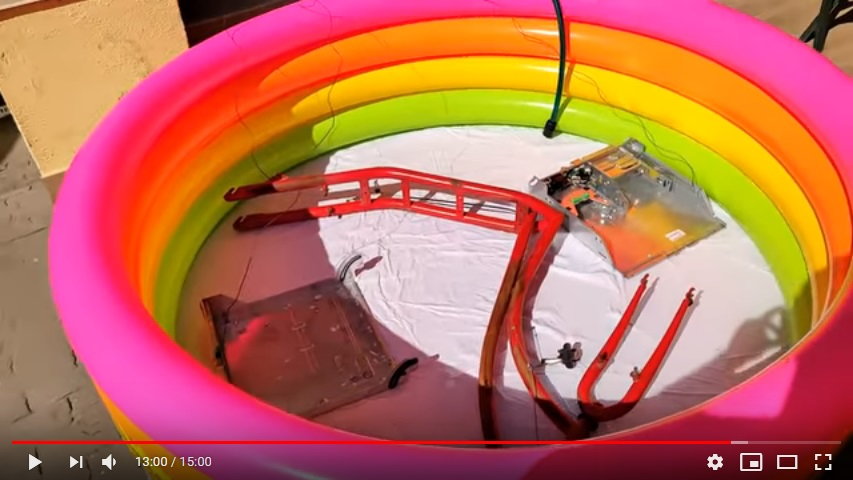
The scrap metal can't touch the bike frame
The chassis -or any scrap metal that can hold a magnet (aluminum won't work)- will 'receive' the rust and must be connected to the positive side of the battery.
The bike frame must be connected to the negative side of the battery.
The bike frame shouldn't touch the scrap metal, of course.
He also used sodium carbonate (soda crystals) to increase the conductivity of the water.
You don't need a giant battery, in fact even a motorcycle one can be enough. This guy used a battery charger to speed up the process. More amperes = faster rust removal.

Never use more than 12 volts, or water might get very hot.
Also, never do this alone. If you get a hand in the water once the power is on you WILL get electrocuted, so instruct your friend to not touch you but to disconnect the battery wires instead.

That's rust floating over the water about halfway through the process.
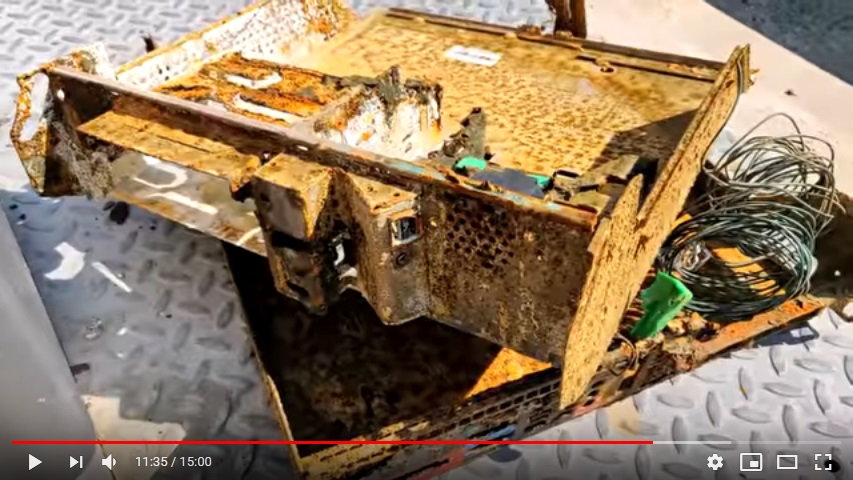
The final state of the sacrificial anode. Look up the fisrt picture for a "before" photo.
Once the process is complete you'll see how the rusted parts are now black. That can be easily removed with water or a Scotch-brite pad.
For the internal parts of the tube, he used a long brush.

High-pressure nozzle removes the black film from the frame with no effort at all.

Bottle-cleaning brush for the tubes.
Once the frame is cleaned and dry, you have to apply a rust inhibitor or the primer coat FAST, because it will start to rust again almost immediately. Have fun!
This guy used an inflatable pool to submerge the entire bike frame and a computer chassis he found on the garbage as a sacrificial anode.

The scrap metal can't touch the bike frame
The chassis -or any scrap metal that can hold a magnet (aluminum won't work)- will 'receive' the rust and must be connected to the positive side of the battery.
The bike frame must be connected to the negative side of the battery.
The bike frame shouldn't touch the scrap metal, of course.
He also used sodium carbonate (soda crystals) to increase the conductivity of the water.
You don't need a giant battery, in fact even a motorcycle one can be enough. This guy used a battery charger to speed up the process. More amperes = faster rust removal.

Never use more than 12 volts, or water might get very hot.
Also, never do this alone. If you get a hand in the water once the power is on you WILL get electrocuted, so instruct your friend to not touch you but to disconnect the battery wires instead.

That's rust floating over the water about halfway through the process.

The final state of the sacrificial anode. Look up the fisrt picture for a "before" photo.
Once the process is complete you'll see how the rusted parts are now black. That can be easily removed with water or a Scotch-brite pad.
For the internal parts of the tube, he used a long brush.

High-pressure nozzle removes the black film from the frame with no effort at all.

Bottle-cleaning brush for the tubes.
Once the frame is cleaned and dry, you have to apply a rust inhibitor or the primer coat FAST, because it will start to rust again almost immediately. Have fun!
#41
Junior Member
Thread Starter
All right, I guess you all are correct, I need to evaluate true bike worth first. Either way I was just exploring possibilities because I got other bikes. All I know about the frame is that it's 1:1 replica of sport frame used by some pro-cyclist, it even had his name on it before I repainted it(forgot, but afaik one of Altig brothers).
@Lightning Pilot
Don't know which zinc paint to use, I found few types, some are called "zinc phosphate primers" but others "cold galvanizers". There are also paints with zinc in name but there's nothing else about them, seems they are meant to be used on zinc(ed) surfaces. I guess I should look for primers, but even among them, when looking at ingredient list(if stated) the amount of zinc could be as low as 2%. Seems there's a big mess on market.
@3alarmer
Not sure what's so funny when people on these forums are suggesting stuff like nail polish. "Roof Guard" or any other similar product produces strong, elastic cover that is completely water-proof and adheres like a glue. The one I got is liquid, doesn't require any primer, is transparent and polyurethane based. There are even spray versions. The only problem I see is possible moisture trapping.
I still need to find out what to use to cover frame holes, including bottom bracket so acid/anything I'll pour in won't drain out. Was wondering about covering the hole between BB and seatpost with plastic wrap and sticking spare inner tube inside, then pumping it to high pressure so it would hold plastic there.
@Lightning Pilot
Don't know which zinc paint to use, I found few types, some are called "zinc phosphate primers" but others "cold galvanizers". There are also paints with zinc in name but there's nothing else about them, seems they are meant to be used on zinc(ed) surfaces. I guess I should look for primers, but even among them, when looking at ingredient list(if stated) the amount of zinc could be as low as 2%. Seems there's a big mess on market.
@3alarmer
Not sure what's so funny when people on these forums are suggesting stuff like nail polish. "Roof Guard" or any other similar product produces strong, elastic cover that is completely water-proof and adheres like a glue. The one I got is liquid, doesn't require any primer, is transparent and polyurethane based. There are even spray versions. The only problem I see is possible moisture trapping.
I still need to find out what to use to cover frame holes, including bottom bracket so acid/anything I'll pour in won't drain out. Was wondering about covering the hole between BB and seatpost with plastic wrap and sticking spare inner tube inside, then pumping it to high pressure so it would hold plastic there.
Last edited by cuyd; 10-06-19 at 12:41 AM.
#42
Senior Member
Join Date: Aug 2019
Location: Peoples Democratic Socialist Republic of Madiganistan (formerly known as Illinois)
Posts: 113
Bikes: Lightning P-38
Mentioned: 1 Post(s)
Tagged: 0 Thread(s)
Quoted: 48 Post(s)
Liked 32 Times
in
26 Posts
All right, I guess you all are correct, I need to evaluate true bike worth first. Either way I was just exploring possibilities because I got other bikes. All I know about the frame is that it's 1:1 replica of sport frame used by some pro-cyclist, it even had his name on it before I repainted it(forgot, but afaik one of Altig brothers).
@Lightning Pilot
Don't know which zinc paint to use, I found few types, some are called "zinc phosphate primers" but others "cold galvanizers". There are also paints with zinc in name but there's nothing else about them, seems they are meant to be used on zinc(ed) surfaces. I guess I should look for primers, but even among them, when looking at ingredient list(if stated) the amount of zinc could be as low as 2%. Seems there's a big mess on market.
{snippage}
I still need to find out what to use to cover frame holes, including bottom bracket so acid/anything I'll pour in won't drain out. Was wondering about covering the hole between BB and seatpost with plastic wrap and sticking spare inner tube inside, then pumping it to high pressure so it would hold plastic there.
@Lightning Pilot
Don't know which zinc paint to use, I found few types, some are called "zinc phosphate primers" but others "cold galvanizers". There are also paints with zinc in name but there's nothing else about them, seems they are meant to be used on zinc(ed) surfaces. I guess I should look for primers, but even among them, when looking at ingredient list(if stated) the amount of zinc could be as low as 2%. Seems there's a big mess on market.
{snippage}
I still need to find out what to use to cover frame holes, including bottom bracket so acid/anything I'll pour in won't drain out. Was wondering about covering the hole between BB and seatpost with plastic wrap and sticking spare inner tube inside, then pumping it to high pressure so it would hold plastic there.
As for plugging frame openings, I suggest rubber stoppers, the kind used in chemical labs. They come in various sizes and are readily available from Amazon and other sites on line. Some Ace hardware stores may carry the smaller sizes, or at least used to. If you plan on doing this again, they can be re-used. Do not use natural cork, or old wine bottle corks, synthetic or not. The rubber stoppers are resistant to most inorganic chemicals and many hydrocarbon solvents.
#43
Friendship is Magic
Join Date: Nov 2010
Location: Sacramento, CA
Posts: 22,984
Bikes: old ones
Mentioned: 304 Post(s)
Tagged: 0 Thread(s)
Quoted: 26382 Post(s)
Liked 10,362 Times
in
7,196 Posts
@3alarmer
Not sure what's so funny when people on these forums are suggesting stuff like nail polish. "Roof Guard" or any other similar product produces strong, elastic cover that is completely water-proof and adheres like a glue. The one I got is liquid, doesn't require any primer, is transparent and polyurethane based. There are even spray versions. The only problem I see is possible moisture trapping.
#44
Friendship is Magic
Join Date: Nov 2010
Location: Sacramento, CA
Posts: 22,984
Bikes: old ones
Mentioned: 304 Post(s)
Tagged: 0 Thread(s)
Quoted: 26382 Post(s)
Liked 10,362 Times
in
7,196 Posts
I still need to find out what to use to cover frame holes, including bottom bracket so acid/anything I'll pour in won't drain out. Was wondering about covering the hole between BB and seatpost with plastic wrap and sticking spare inner tube inside, then pumping it to high pressure so it would hold plastic there.
#45
Junior Member
Thread Starter
Finally I've managed to get camera back. I am unsure what kind of frame it is, I've made second topic about it: https://www.bikeforums.net/classic-v...ied-frame.html
Anyway I got few more pictures of external and internal rust. I am unable to remove BB yet. There was lot of gunk in the lower parts of seat tube, I couldn't reach it properly but I've also noticed that seat tube must have had some grease inside, maybe a rust-preventive measure.
There are bits of paint still remaining, original fluorescent green and white/black repaint.

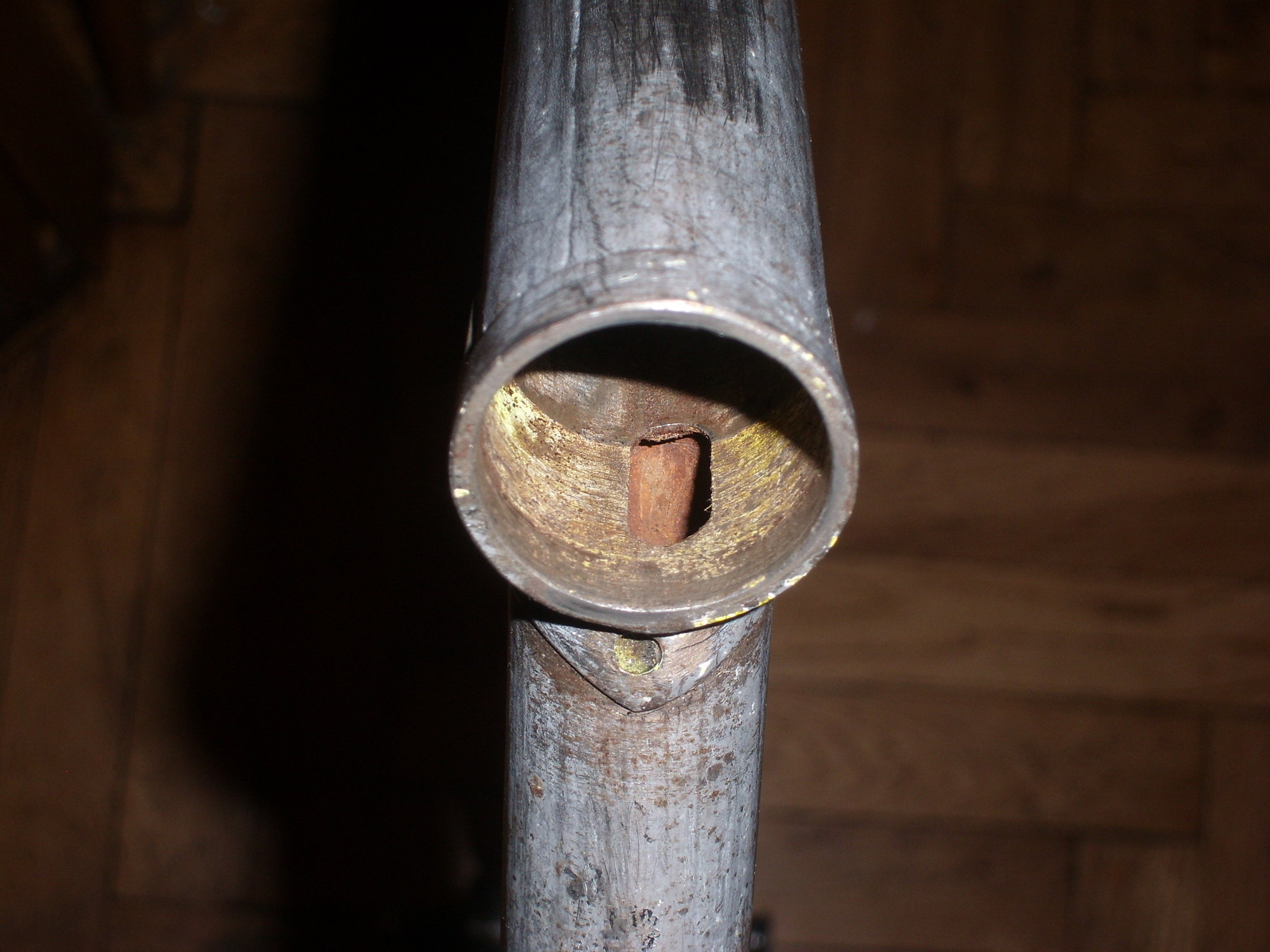
I found it funny that it's not aligned properly but the rust inside is evident.


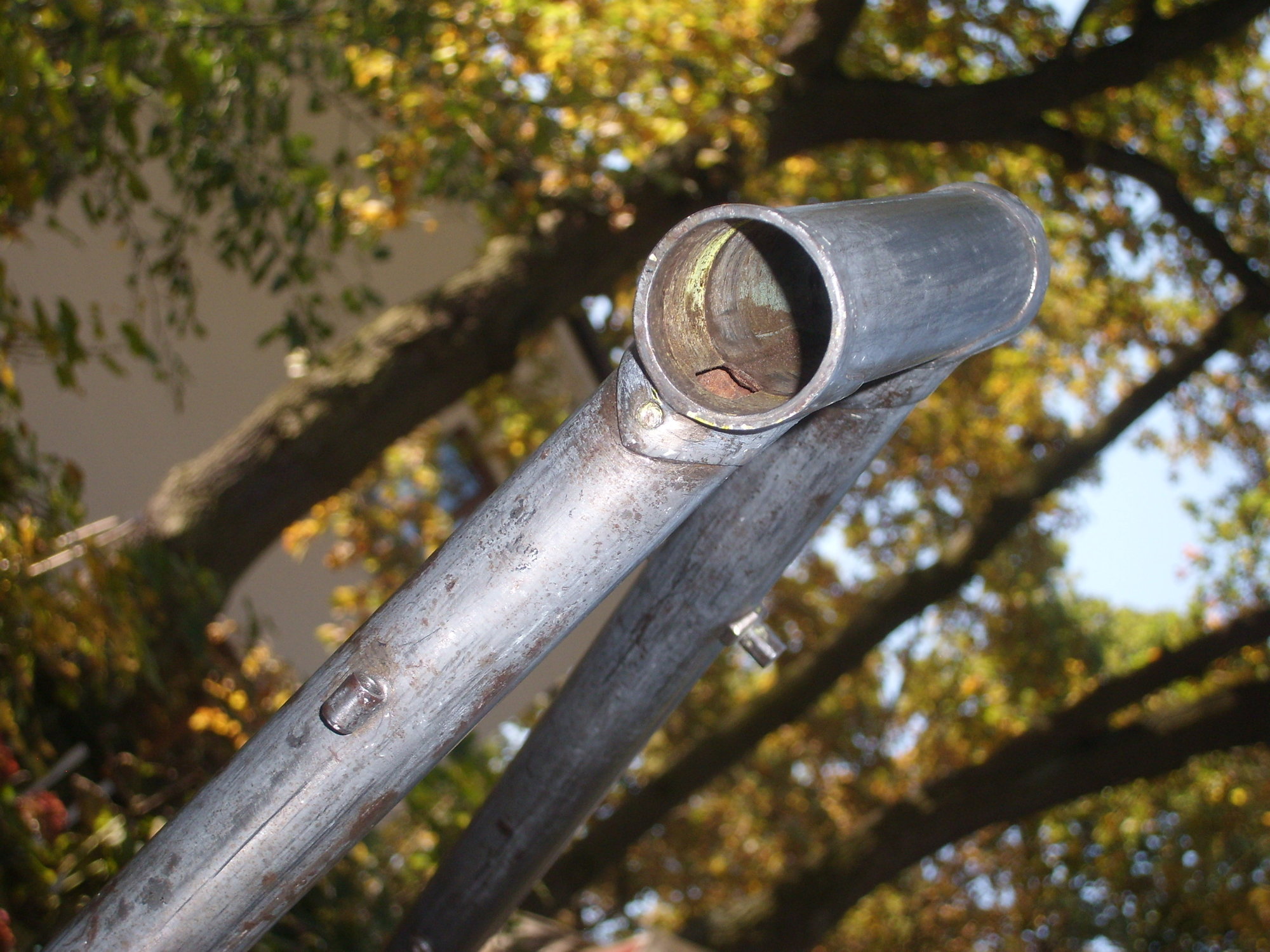

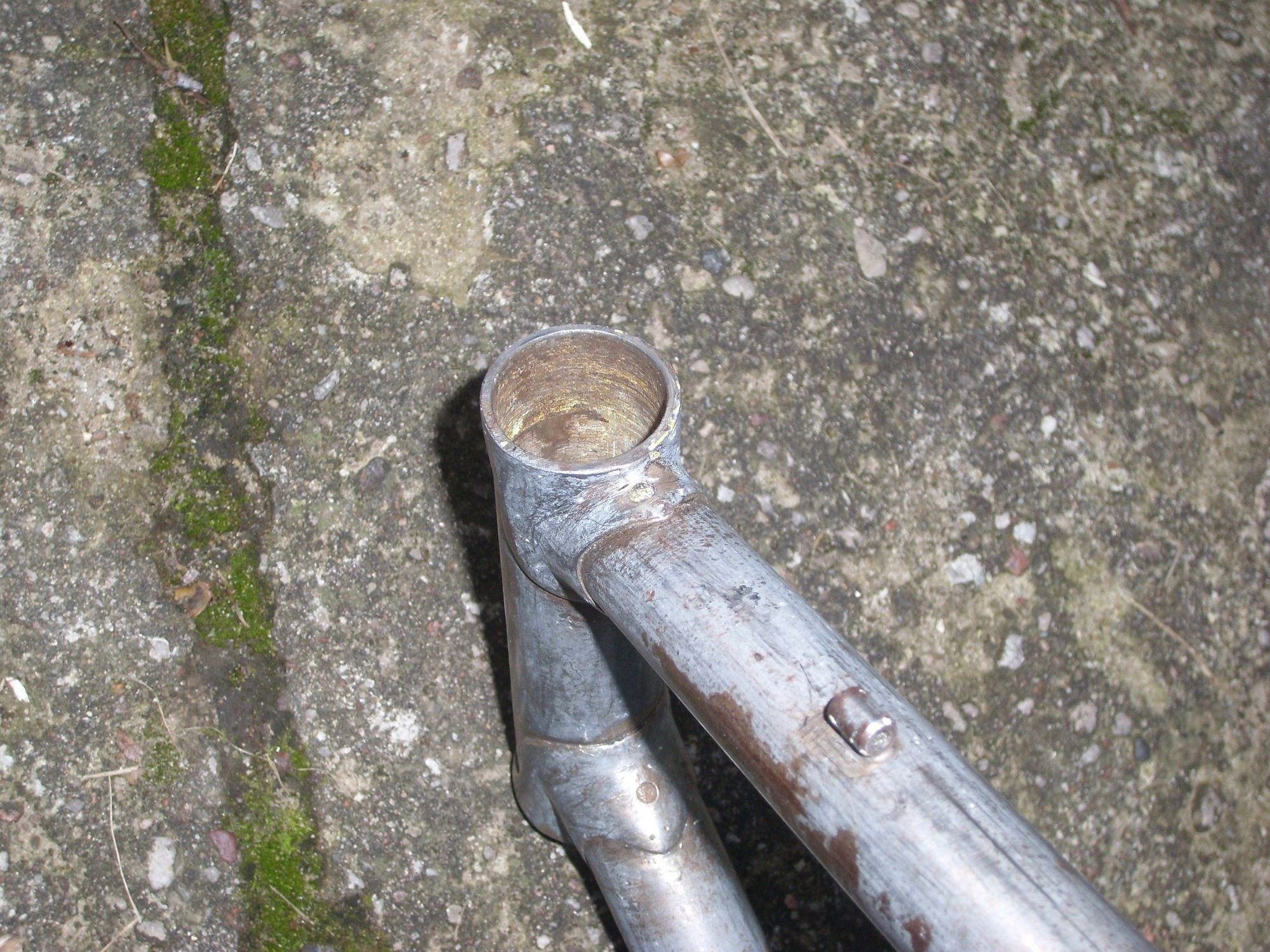
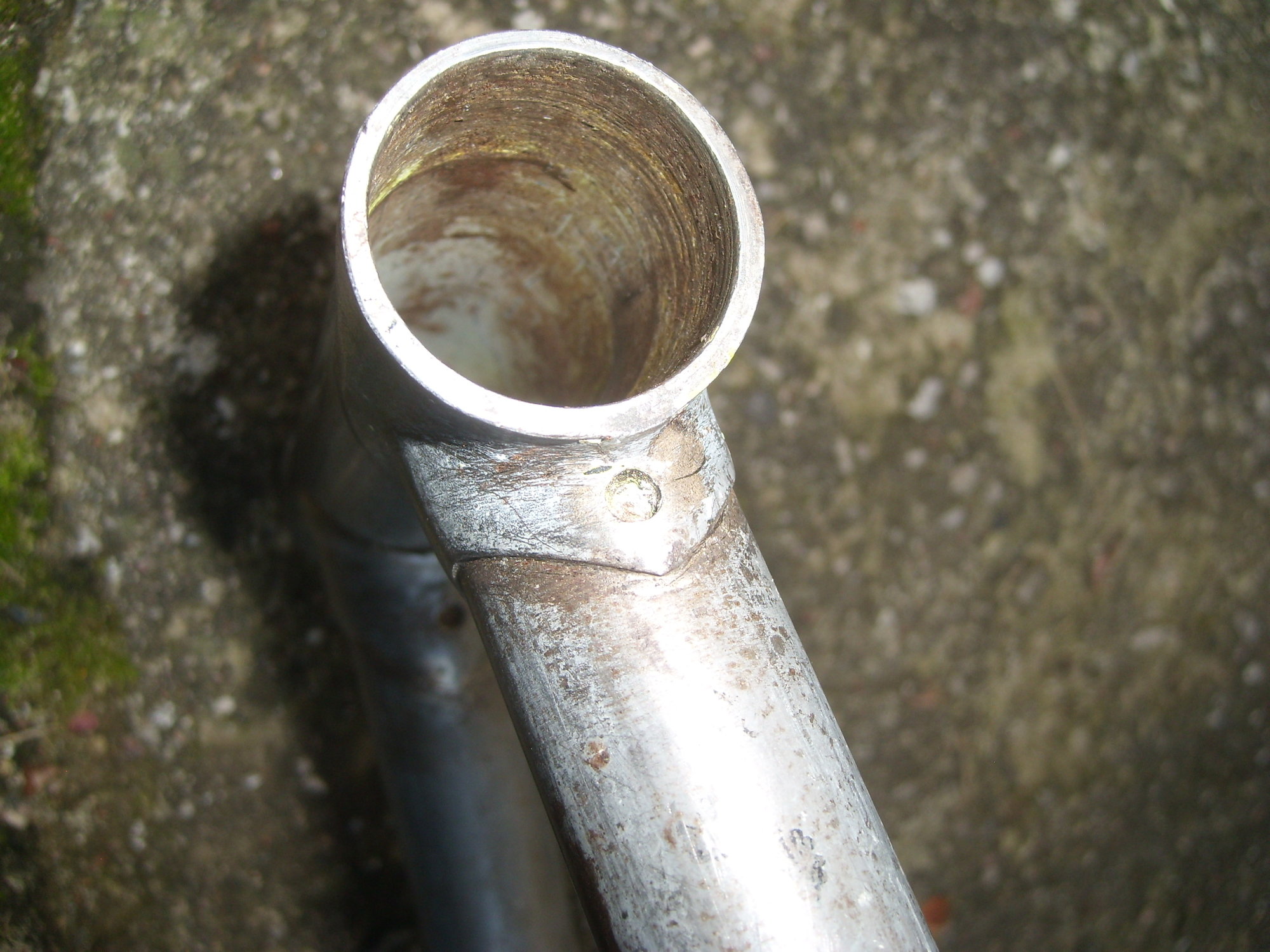
Anyway I got few more pictures of external and internal rust. I am unable to remove BB yet. There was lot of gunk in the lower parts of seat tube, I couldn't reach it properly but I've also noticed that seat tube must have had some grease inside, maybe a rust-preventive measure.
There are bits of paint still remaining, original fluorescent green and white/black repaint.


I found it funny that it's not aligned properly but the rust inside is evident.






#46
Senior Member
Join Date: Aug 2019
Location: Peoples Democratic Socialist Republic of Madiganistan (formerly known as Illinois)
Posts: 113
Bikes: Lightning P-38
Mentioned: 1 Post(s)
Tagged: 0 Thread(s)
Quoted: 48 Post(s)
Liked 32 Times
in
26 Posts
Most, if not all, of that looks pretty superficial. I don't see any serious corrosion at the welds. If it were me, I'd use dilute (10%) phosphoric acid on the inside, wet sand the exterior (use elbow grease—it's great stuff!  )
)
 )
)
#47
Junior Member
Thread Starter
Is it fine to leave bottom bracket inside if I won't be able to remove it? As long as I would be able to isolate frame internals for acid bath. I had already huge problems with taking off fork, and worse it turned out to be bend to the side. I was thinking about securing fork legs with long bolt and four nuts(to ensure proper distance), putting steering tube into vise and applying force to secure legs so they both would move to the side. But AFAIK it's bit risky, I could also true front wheel with small offset to the bent side and/or grind one leg a bit to ensure that wheel stays parallel to the ground. Any takes?


And here's another thing, looks like something is missing. Should bottom bracket be replaced?
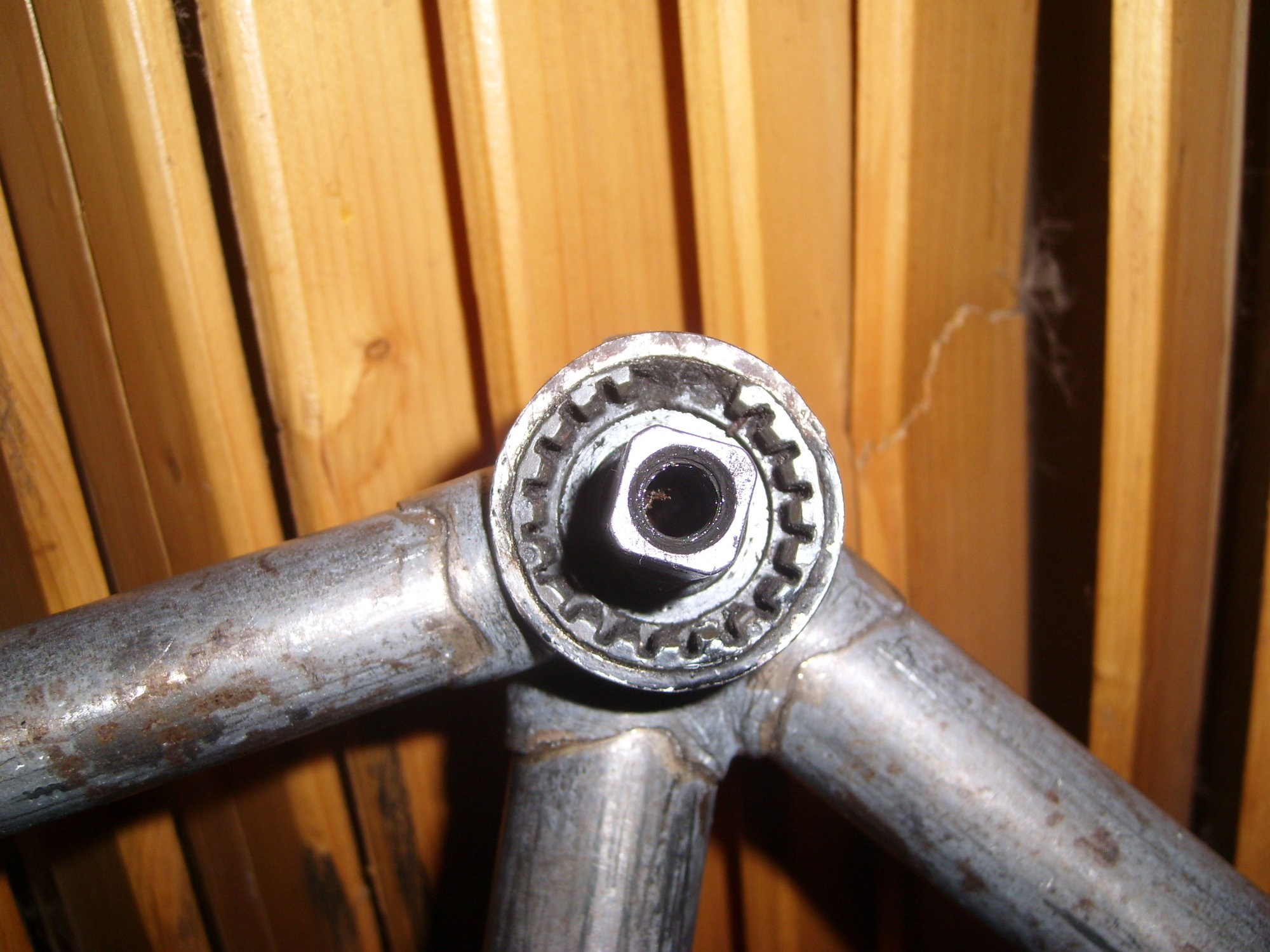


And here's another thing, looks like something is missing. Should bottom bracket be replaced?

Last edited by cuyd; 10-15-19 at 01:21 PM.
#48
Junior Member
Thread Starter
I'd like to ask, would using polishing paste after sanding help with de-rusting? I've tried a bit and surface looks really clean, I can see myself like in mirror - to be honest it looks much cleaner than chromed steel. Was also thinking about using polishing paste and then painting it with some colorless paint/lacquer(not sure what), just for the looks but I guess it wouldn't have any serious rust protection that is offered by proper paint.
#49
Senior Member
Join Date: Aug 2015
Posts: 3,283
Mentioned: 39 Post(s)
Tagged: 0 Thread(s)
Quoted: 1135 Post(s)
Liked 1,727 Times
in
951 Posts
I'd like to ask, would using polishing paste after sanding help with de-rusting? I've tried a bit and surface looks really clean, I can see myself like in mirror - to be honest it looks much cleaner than chromed steel. Was also thinking about using polishing paste and then painting it with some colorless paint/lacquer(not sure what), just for the looks but I guess it wouldn't have any serious rust protection that is offered by proper paint.
#50
Senior Member
Join Date: Aug 2015
Posts: 3,283
Mentioned: 39 Post(s)
Tagged: 0 Thread(s)
Quoted: 1135 Post(s)
Liked 1,727 Times
in
951 Posts
I would extract the bb, even if itself is good, it does look like it's had some damage to the spline. The fork I would check alignment rake and length before correcting, I would not grind, I'd secure and manipulate into position.








